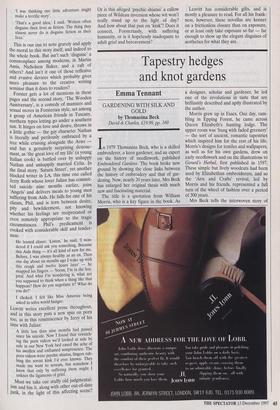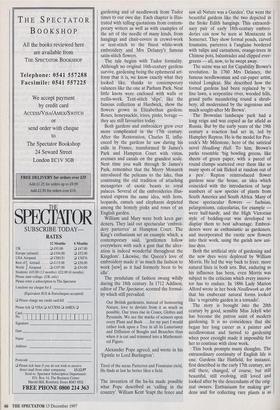Tapestry hedges and knot gardens
Emma Tennant
GARDENING WITH SILK AND GOLD by Thomasina Beck David & Charles, 179.99, pp. 160 L1979 Thomasina Beck, who is a skilled embroiderer, a keen gardener, and an expert on the history of needlework, published Embroidered Gardens. The book broke new ground by showing the close links between the history of embroidery and that of gar- dening. Now, nearly 20 years later, Mrs Beck has enlarged her original thesis with much new and fascinating material.
The title is a quotation from William Morris, who is a key figure in the book. As a designer, scholar and gardener, he led one of the revolutions in taste that are brilliantly described and aptly illustrated by the author.
Morris grew up in Essex. One day, ram- bling in Epping Forest, he came across Queen Elizabeth's hunting lodge. The upper room was 'hung with faded greenery' — the sort of ancient, romantic tapestries which inspired him for the rest of his life. Morris's designs for textiles and wallpapers, as well as for his own gardens, drew on early needlework and on the illustrations to Gerard's Herbal, first published in 1597. These simple but lively woodcuts had been used by Elizabethan embroiderers, and so the 'Arts and Crafts' revival, led by Morris and his friends, represented a full turn of the wheel of fashion over a period of 300 years.
Mrs Beck tells the interwoven story of gardening and of needlework from Tudor times to our own day. Each chapter is illus- trated with telling quotations from contem- porary writers as well as with examples of the art of the needle of many kinds, from hangings and chair-covers in crewel-work or tent-stitch to the finest white-work embroidery and Mrs Delaney's famous satin-stitch flowers.
The tale begins with Tudor formality. Although no original 16th-century gardens survive, gardening being the ephemeral art- form that it is, we know exactly what they looked like, thanks to contemporary valances like the one at Parham Park. Neat little knots were enclosed with walls or trellis-work. Tent-stitch 'slips', like the famous collection at Hardwick, show the flowers grown in Elizabethan gardens. Roses, honeysuckle, irises, pinks, borage — they are still favourites today.
Both gardens and embroidery grew ever more complicated in the 17th century. After the Restoration, Charles II, influ- enced by the gardens he saw during his exile in France, transformed St James's Park and Hampton Court with vistas, avenues and canals on the grandest scale. Next time you walk through St James's Park, remember that the Merry Monarch introduced the pelicans to the lake, thus continuing the old tradition of attaching menageries of exotic beasts to royal palaces. Several of the embroideries illus- trated express the same idea, with lions, leopards, camels and elephants depicted among the homely pinks and roses of an English garden.
William and Mary were both keen gar- deners. They laid out spectacular 'embroi- dery parterres' at Hampton Court. The King's enthusiasm set an example which, a contemporary said, 'gentlemen follow everywhere with such a gust that the alter- ation is indeed wonderful throughout the Kingdom'. Likewise, the Queen's love of embroidery made it 'as much the fashion to work [sew] as it had formerly been to be idle'.
The pendulum of fashion swung wildly during the 18th century. In 1712 Addison, editor of The Spectator, scorned the formal- ity which still prevailed: Our British gardeners, instead of humouring Nature, love to deviate from it as much as possible. Our trees rise in Cones, Globes and Pyramids. We see the marks of scissors upon every Plant and Bush. . for my part I would rather look upon a Tree in all its Luxuriancy and Diffusion of Boughs and Branches than when it is cut and trimmed into a Mathemati- cal Figure.
Alexander Pope agreed, and wrote in his 'Epistle to Lord Burlington': Tired of the scene Parterres and Fountains yield, He finds at last he better likes a field.
The invention of the ha-ha made possible what Pope described as 'calling in the country'. William Kent 'leapt the fence and saw all Nature was a Garden'. Out went the beautiful gardens like the two depicted in the Stoke Edith hangings. This extraordi- nary pair of early 18th-century embroi- deries can now be seen at Montacute in Somerset. They show formal ponds, carved fountains, parterres a l'anglaise bordered with tulips and carnations, orange-trees in Chinese pots, balustrades and clipped ever- greens — all, now, to be swept away.
The scene was set for Capability Brown's revolution. In 1760 Mrs Delaney, the famous needlewoman and cut-paper artist, visited Longleat. She described how the formal gardens had been replaced by 'a fine lawn, a serpentine river, wooded hills, grand paths meandering round a shrub- bery, all modernised by the ingenious and much sought-after Mr Brown'.
The Brownian landscape park had a long reign and was copied as far afield as Russia. But by the early years of the 19th century a reaction had set in, led by Humphry Repton. He is the model for Pea- cock's Mr Milestone, hero of the satirical novel Headlong Hall. To him, Brown's parks resemble `big bowling greens, like sheets of green paper, with a parcel of round clumps scattered over them like so many spots of ink flicked at random out of a pen'. Repton reintroduced flower gardens near the house, an idea which coincided with the introduction of large numbers of new species of plants from South America and South Africa. Many of these spectacular flowers — fuchsias, pelargoniums, calceolarias, for example — were half-hardy, and the High Victorian style of bedding-out was developed to display them to best advantage. Embroi- derers were as enthusiastic as gardeners, and incorporated the exotic new flowers into their work, using the garish new ani- line dyes.
Both the artificial style of gardening and the new dyes were deplored by William Morris. He led the way back to freer, more natural lines in both arts. But, enduring as his influence has been, even Morris was subject to the criticism which every innova- tor has to endure. In 1886 Lady Marion Alford wrote in her book Needlework as Art that his exuberant natural forms looked like 'a vegetable garden in a tornado'.
The story is brought into the 20th century by good, sensible Miss Jekyll who has become the patron saint of modern gardening. It is no coincidence that she began her long career as a painter and needlewoman and turned to gardening when poor eyesight made it impossible for her to continue with close work.
• This book prompts many thoughts. The extraordinary continuity of English life is one. Gardens like Hatfield, for instance, first described in the early 17th century, are still there, changed, of course, but still beautiful, still evolving, still loved and looked after by the descendants of the orig- inal owners. Enthusiasm for making gar- dens and for collecting rare plants is as great as ever. Visiting gardens, a craze which goes back for hundreds of years, is even more popular than hitherto, and is a pleasure now available to everyone, since so many parks and gardens are open to the public. The art of the needle is flourishing too, encouraged and inspired by writers like Mrs Beck. She illustrates modern works by embroiderers like Paddy Killen, Janet Haigh and Roy and Barbara Hirst, which are among the most beautiful things in the book.
The sister arts and crafts of gardening and needlework represent two strands of beauty and sanity in the often crazy tapestry of modern life. When the last dead cow has been taken from the Royal Acade- my back to the abattoir where it belongs, these lovely works of art will continue to fascinate and inspire another generation.




















































































 Previous page
Previous page